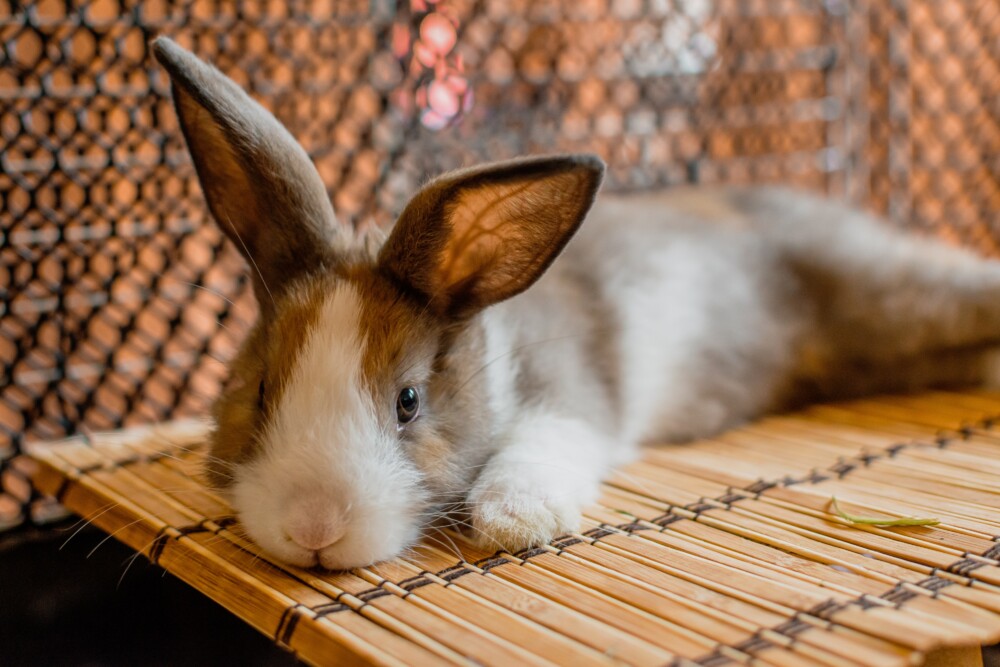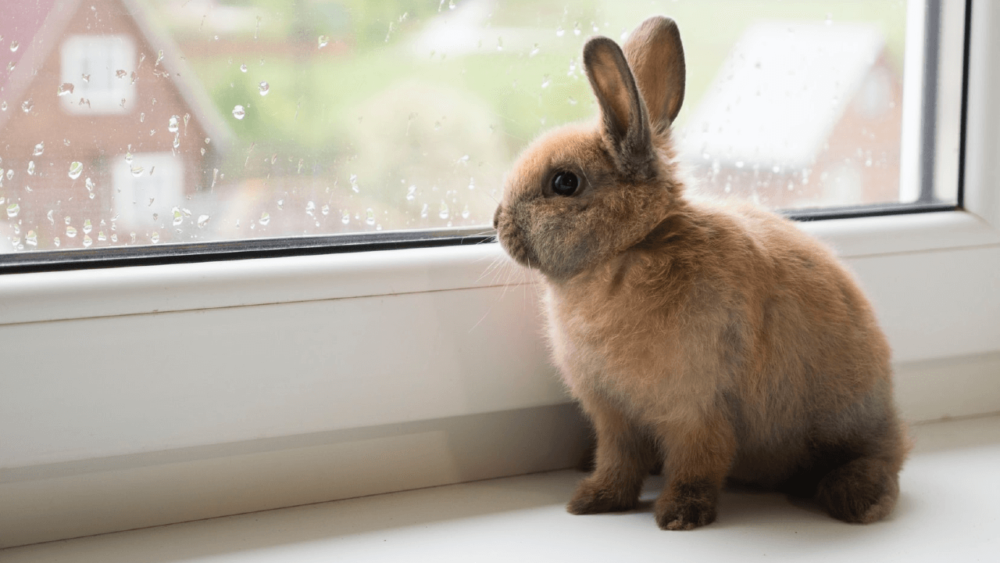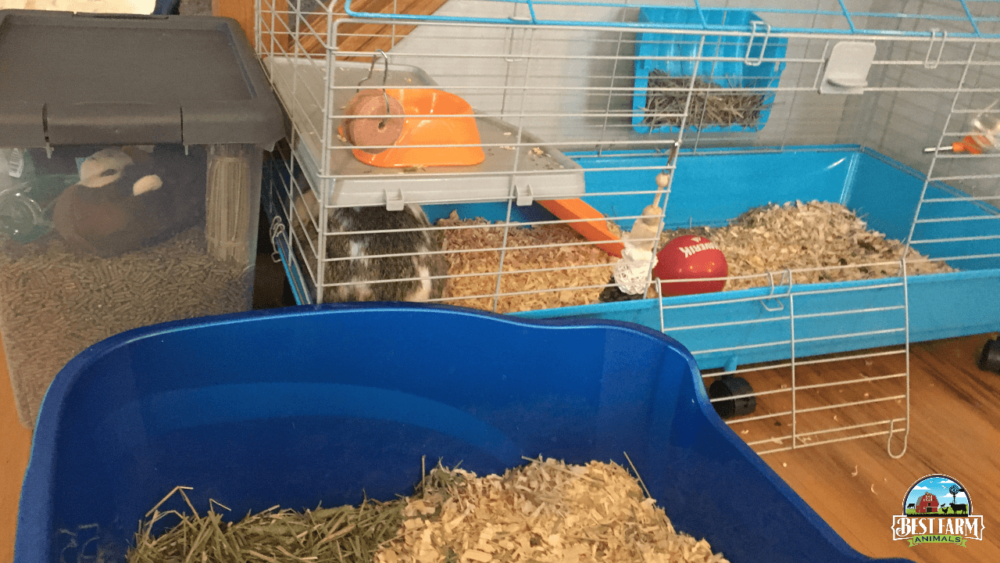It was my family’s first winter at the homestead, and the winters out here can be harsh. The children begged us to move their bunnies into the house for the winter, as it was simply too cold to leave them in their outdoor rabbit enclosure.
My husband and I tried to figure out how this new arrangement would work. Each rabbit produces over 200-300 poop pellets per day (that’s a lot of poop), and they urinate 2 to 8 times a day. Who was going to clean up all that mess?
We agreed that we would only allow the kids’ bunnies to move into the house if they were all litter trained. We didn’t know where to begin, but a local rabbit breeder had some useful pointers.
How do you litter train your rabbit? Littler train your rabbit with a consistently placed litter box and relocate pellets into the litter box. Rabbits use one area as a poop area. Start by placing your rabbits in an enclosed area. You can litter train them by placing a litter box or tray in a corner of the enclosure so it is easily accessible to your rabbit.
Rabbits tend to use the same area when doing their “business.” Make sure the enclosure or cage where you train them is small, and you can gradually increase the space as your rabbit’s potty habits improve.
Tools and Equipment for Litter Training Your Rabbit
Litter training your rabbit does require patience, but before you get started with the training, there are some tools and equipment you will need:
- A cage or closed off area
- 3 to 5 litter boxes (cat litter trays work well) for every 1 to 2 bunnies
- Litter
- Hay
- A small shovel or poop scoop
- Pet-friendly cleaning spray (you can also use vinegar mixed with equal parts water)
- Old newspapers
15 Steps to Litter Train Your Rabbit
Like cats and dogs, litter training or potty training your rabbit can be frustrating. However, rabbits naturally like to keep themselves clean and prefer to urinate or poop in one or two places, making training your bun to use a litter box a lot easier once you know what you’re doing.
Here are 15 steps to help you litter train your rabbit:
1. Choose the Right Space
Ensure you have a small area for your rabbit to litter train in. Corner off an area of their cage until they are litter trained. If their cage is too large, your rabbit will struggle to choose a potty area. Smaller spaces make it easier for the rabbits to stick to using the same designated potty area.
2. Corner the Potty Spot
Choose a corner in your rabbit’s hutch or enclosure to set up the litter box. Bunnies like to press their butts back into a corner (as far as they can) when they urinate or poop. If your rabbit chooses a different corner, move the tray accordingly or place another tray in that spot.
A neat trick: scoop up the poop that missed the box and place it in the litter box, as if saying to your rabbit, “Here’s the spot, Fluffle.”
3. Marking the Potty Place
Lay out sheets of newspaper in your rabbit’s enclosure. If your bun urinates on the newspaper (outside of the litter tray), place the pee-stained newspaper at the bottom of the litter box.
The urine smell will encourage your rabbit to use the litter box in future. Keep doing this until your rabbit stops urinating outside the box. Keep laying out fresh newspaper around the litter box so they can clearly identify where the potty area is.
4. Eating Arrangements While Pooping
Rabbits naturally eat and poop at the same time. Place some hay in a hayrack or hay dispenser above the litter box or at the end of the litter box. Doing this will encourage your rabbit to use the litter box.
Make sure your rabbit has to climb into the box to nibble on the hay. Otherwise, your bun will sit outside the box and eat (and poop).
5. Keep It Clean
Make sure the area is kept clean to monitor your rabbit’s potty habits. Also, if you keep the area clean, your rabbit will follow suit. Rabbits love mimicking us, so set a good example.
You can clean the area with a safe homemade spray of equal amounts of water and vinegar. This solution is safe to use with your rabbits and eliminates the risk of your rabbit ingesting harmful cleaning chemicals. The vinegar will help neutralize the ammonia smell of the urine in the litter tray.
6. Repeat the Corrections
Continue to scoop up poop pellets, collect the urine-soaked newspaper, and place these in your rabbits’ litter box until your rabbits start getting the hang of it. This repetitive behavior is also how you bond with your rabbit.
7. Make It Clear
Keep absorbent materials such as cardboard, fleece blankets, and towels away from the litter box until your rabbit is fully litter trained. The smell of urine all over the cage can confuse your rabbit and make litter training take longer.
Once the rabbits are fully litter trained, you can make a nice and cozy sleeping spot for them, but while they train, you don’t want to give them things to pee on.
8. Introduce More Space
After a few days have passed and your rabbit has started to get a feel for the litter training, give your rabbit more space to explore and exercise. Perhaps allow them to explore the room. Do not allow them to roam your house freely just yet. This is also a good time to enlarge the rabbit cage.
9. Make More Litter Spaces
Add a few litter boxes to the larger area that you have allowed your bun to explore. Adding poop pellets and urine-stained newspaper will help your rabbit associate the new litter boxes with the potty area.
10. Monitor Potty Behavior
Keep a close eye on your rabbit as they explore, and watch out for any cues that they are about to poop or pee. A rabbit will lift its tail when it’s about to pee or poop.
11. Corrective Direction
Shout “no” if you notice your rabbit’s tail lifting to pass urine. Gently usher your rabbit back to the nearest designated litter box and offer a treat such as fresh hay, herbs, or a piece of apple while they potty (you don’t want your bun to feel that you are punishing it). A bit of verbal praise is also welcome.
12. Be on Clean Up Alert
Make sure to clean up any accidents outside of the litter boxes as soon as possible to avoid confusing your rabbit. Remember, rabbits will poop or pee where they smell previous business. Scoop up the wayward pellets and place them in the multiple trays that you have set up. Disinfect the area with your pet-friendly vinegar spray to remove the ammonia scent that will attract your rabbit to pee in the wrong spot again.
13. Build Trust and Freedom
Slowly start increasing the time that you let your bun out to explore. Do this 3 – 4 times a day for about 15 – 30 minutes at a time. As your rabbits’ potty habits improve, you can start letting them out for more extended periods.
14. Praise the Positive, Ignore the Negative
Rabbits are not perfect and will have accidents. Make sure to praise your rabbit when it uses the litter box correctly. Giving your rabbit treats will also be a good reward. When they slip up and have an “oopsie” on the rug, it’s pointless to try and “discipline” them when they have already done it before you caught them. Rather save your energy to reward the right potty attempts.
15. Free Rein
Once your rabbit is using the litter tray properly, you can start removing the space limitations so they have more freedom to roam.
Don’t rush into this, and instead take things slow, so your rabbit understands that you still want them to use the litter box when they pee and poop. Accidents will happen, and if you can catch them in the act, usher them back to the litter tray to complete their “business.”
If your rabbit starts repetitively doing their “business” outside the litter boxes again, check whether they have developed a health problem such as a kidney stone or bladder infection.
Perhaps you moved them to freedom before they were ready? Never hesitate to take a few steps back to retrain your rabbit to correctly use the litter box.
Why Is It Important to Litter Train a Rabbit?
Rabbits poop an average of 200-300 pellets each per day and having multiple rabbits increases this amount drastically. Their urine has a powerful ammonia-tinged smell. So, litter training your bun will benefit you and your rabbits.
Here are several reasons why it’s important to litter train a rabbit:
- Less mess and easier to clean up
- Keep track of your rabbit’s health
- More hygienic for you and your bun
- Gives your rabbit a space of their own
- More freedom to roam
- You don’t need to keep such a close eye on your rabbit regarding their potty habits
- The house will not smell like urine
When Should You Litter Train Your Rabbit?
Young rabbits are challenging to train because they have shorter attention spans than older rabbits. When puberty kicks in (around 3 months of age), their litter training habits become inconsistent because their hormones are all over the place. They may become more territorial and aggressive, making litter training difficult. Therefore, it’s best to wait until your rabbit is neutered or spayed before you begin litter training.
Re-Training a Rabbit for the Litter Box
You can start litter training your rabbit at around 4 months old, but you should make sure your rabbit is spayed or neutered before you start the training.
One of the children from our neighboring homesteads had an older rabbit. This bun lived indoors when it was young. The rabbit had been living happily in an outdoor enclosure for quite a few years now.
The rabbit developed arthritis and they had to move the rabbit back into the house. The couple needed to re-train their bunny to use the litter box.
If you have a similar situation, here are 4 easy steps to retrain your older rabbit to use the litter box:
1. Limit Space and Set Up the Litter Station
Make sure your rabbit is in a small enclosure or cage. Place the litter box in a corner and put some of the rabbit’s poop pellets and urine into the litter box to encourage your rabbit to use the litter box.
2. Fill the Litter Box and Food Box
Fill the litter box with a layer of litter and place hay at the far end of the box. This will allow your bun to poop and pee while it nibbles on the hay.
3. Proving Time
Keep your bun in the cage until they are using the litter box properly, and make sure they can keep the cage or enclosure clean.
4. Freedom and Careful Monitoring
Once your rabbit’s potty habits have improved, let them out to explore. Keep an eye on your rabbit for a couple of days, and make sure that the litter boxes are easily accessible for your bun.
Litter Training Problems and Solutions
Rabbits are highly intelligent animals, but they are driven by instinct. Even though your bun may have taken to their litter box well, there is still a chance you may experience a few problems along the way:
Rabbit Won’t Stay in the Litter Box
Your rabbit may have difficulties adjusting to their litter box because they haven’t been neutered or spayed. Rabbits are territorial, and if their hormones are in full swing, they will want to mark their territory by leaving droppings and spraying urine everywhere (except for in the litter box).
Solution: A simple and effective way to prevent territorial behavior in your rabbit is to have them neutered or spayed. You can also purchase a rabbit exercise pen to keep your rabbit close to the litter box but out of your home.
Peeing Out of the Litter Box
Sometimes your rabbit’s backside can hang over the litter box when it urinates, and they end up messing on the floor. Your bun probably isn’t even aware that this is happening.
Solution: You can purchase a puppy pee pad and place it underneath your litter box to absorb the urine that runs over it. You could also buy a larger litter tray with higher sides to prevent your rabbit’s backside from hanging over the edge.
Rabbit Is Digging in the Litter Box
Digging comes naturally to rabbits, and some rabbits enjoy digging and kicking the contents out of the litter box, which makes a lot of mess.
Solution: Purchase a cat litter box with a cover, but you will need to show your rabbit that this is still a litter box by leaving poop pellets and urine in the box. Also ensure there is a suitable area for digging such as a box with wood pellets or sawdust flakes.
Rabbit Sleeps in their Litter Box
Your rabbit might find their litter box cozy and decide to sleep in it. This is perfectly normal for rabbits, though it can leave their fur messy and increase the risk of flystrike, which can be fatal to rabbits.
Solution: Make sure to clean the litter box often to prevent bacteria and odors. Ensure there’s a cozy sleeping area for the rabbit to sleep in (away from the litter box) and where there’s fresh hay to chew.
Rabbit Leaves a Couple of Poop Pellets About
Even if your bun is fully potty trained, it’s normal to find the odd poop pellet here and there. Unfortunately, this is a territorial instinct.
Solution: Even if you neuter or spay your rabbit, this territorial habit will never completely disappear. Poop pellets are dry and can quickly be scooped up, and they don’t have a smell (to humans). As long as your rabbit is healthy, you can simply pick up these stray poop balls or vacuum them up.
Conclusion
Rabbits are wonderful pets, and training them to use the litter box was a great experience for the rabbits and my children. Litter training rabbits has many benefits, and my children have learned to take turns cleaning the litter box and looking after their rabbits. As an added bonus, my kids now know why they should keep their rooms clean and tidy too.
By following the local rabbit breeder’s easy steps, our rabbits are now fully litter trained. They are enjoying their new indoor home, just in time for winter, with a clean and hygienic living space.
Recommended Rabbit Supplies
This list contains affiliate products. Affiliate products do not cost more but helps to support BestFarmAnimals and our goal to provide farm animal owners with accurate and helpful information.
Housing: If your rabbit is indoor, you’ll need a cage, a hideout (to keep your rabbit from death by heart attack), and a space for it to get exercise and spend time with you. If you don’t want to let it run free in your house, this animal playpen provides space and keeps your rabbit from hiding under your couch.
If you keep your rabbit outdoors, an outdoor hutch that provides space and protection from predators is needed. (I’d still keep mine in a barn for further protection from the elements.)
You’ll also need bedding, toys, a grooming brush, and treats for your little friend. A litter box is important because rabbits can be potty trained. Timothy hay is the best kind of hay for rabbits as alfalfa is too sweet. Don’t forget a water drinker. I like the half-gallon waterer because it can cover two rabbits for several days. Pair it with a food bowl or a food manger (a little cleaner) and you’ll be set up!
If you want to treat your bunny to entertainment, a cat tower, a treat ball, or bunny toys all work wonderfully.
Finally, if you plan on taking your rabbit with you on trips, you’ll need a carrier. Here’s a small carrier or larger carrier that work great for occasional travel. If you travel a lot, you might want the carrier that’s rated #1 in safety for safe travels
Lastly, I use this odor eliminator for accidents and to wipe out the bottom of the cage and litter box when I clean it.





